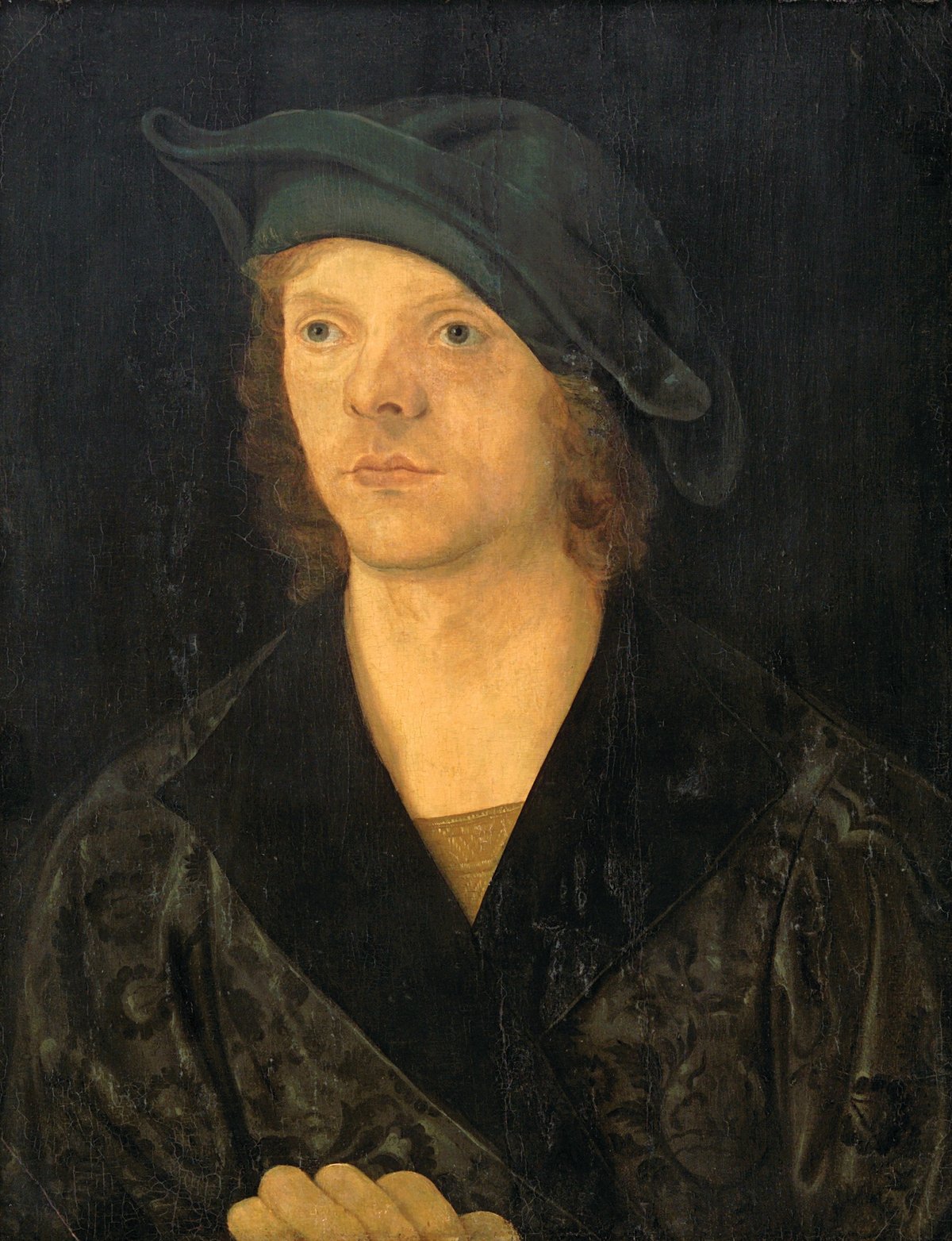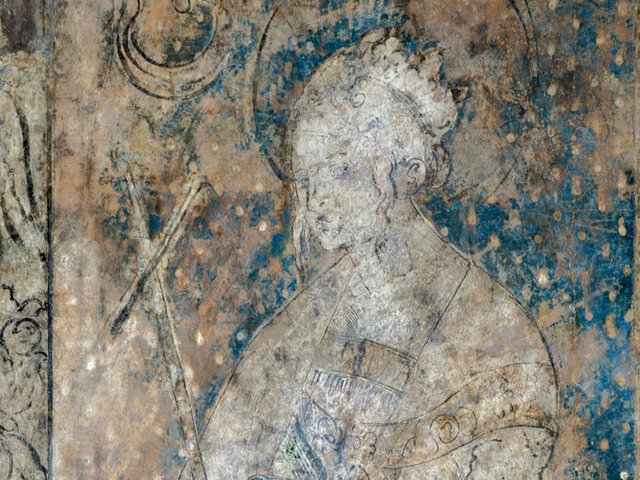In his 1547 manuscript account of the “most important artists and craftsmen” who had worked in Nuremberg over the previous hundred years, Johann Neudörffer briefly mentioned one “Jacob, Walch genannt, Maler”. He knew little about him: he had only seen two of his pictures, one of which he had forgotten about, the other a portrait; Hans von Kulmbach had been his pupil. A fuller picture only emerged in the 19th and 20th centuries as scholars brought together a series of prints and paintings, some signed simply with a caduceus, and associated them with the name of Jacopo de’ Barbari.
Even now his dates of birth and death are unknown, as is his place of birth or where he trained. Between about 1500 and 1516, he was active in the Holy Roman Empire and worked for several prominent patrons, including Emperor Maximilian I. According to Jay Alan Levenson, de’ Babari “was the first Italian artist of note to have journeyed over the Alps and worked in the courts of northern Europe”. Yet his oeuvre – seven signed paintings, two unsigned and two attributed, two drawings, 30 copperplates, of which four are unsigned, and three woodcuts – remains little known and there is little consensus on the precise nature of his role. Above all, the question that preoccupied many German scholars remains unanswered: did he influence Dürer or did Dürer influence him?
The fact that only four paintings and one woodcut are dated has frustrated attempts to construct a plausible chronology of de’ Barbari’s work which might shed light on the question of influence. Beate Böckem’s meticulous new study, Jacopo de’ Barbari. Künstlerschaft und Hofkultur um 1500, adopts a rather different approach. She has reviewed all the published material, found numerous references to de’ Barbari in the archives and subjected his major works, including the painting of St Oswald rediscovered in 2012 in the Slovak National Museum’s Kaštieľ Betliar, to detailed stylistic examination. The result is the most comprehensive account to date of this fascinating artist, which also sheds light on the state of patronage in the Holy Roman Empire around 1500.
In a draft of the dedication of his Four Books on Human Proportion, Dürer wrote that de’ Barbari was born in Venice. Other sources echo this, but there is no firm evidence. “Walch”, after all, is probably just a variant of “welsch”, which simply meant “Italian”. It seems that Barbari may have been working in Venice from about 1480. He was certainly still there in the late 1490s, as evidenced by his massive woodcut aerial view of the city dated 1500.
Yet Böckem believes that this cannot justify the claim some make that he was a Venetian painter, for a great variety of masters and workshops worked in idiosyncratic styles in Venice and the Veneto at the time. She suggests rather that the distinctive stylistic elements that de’ Barbari might have learned in Venice—a softness of touch in the treatment of surface, richness and fullness of clothes, a predilection for realistic elements in his paintings and a certain quiet and festive quality in his compositions—were formed into a mature style in Germany.
On 8 April 1500 Maximilian I hired de’ Barbari as portrait painter and book illustrator at Augsburg. Böckem suggests that he might have travelled there from Freiburg in the retinue of Maximilian’s second wife Bianca Maria Sforza as she journeyed to join her husband at the Augsburg Diet. He was given a horse and required to be available in Nuremberg where he worked sporadically on Maximilian’s commissions and interacted with Dürer and other artists of the school of Michael Wolgemut. He may also have taught Hans von Kulmbach. Dürer eventually deleted his acknowledgement of de’ Barbari’s role in the development of his work on human proportion in favour of a dedication to the Humanist scholar and patrician Willibald Pirckheimer. Yet Dürer undoubtedly knew de’ Barbari and his work and his own stay in Venice 1495-96 would also have provided common ground
Between 1503/04 and 1505 de’ Barbari worked for Frederick the Wise of Saxony, who was at that time elaborating his court and establishing Wittenberg as an academic and cultural centre. De’ Barbari had introduced himself to the elector between 1501 and 1503 by a written address in which he advertised himself as an artist with great classical learning, as conversant with Ovid’s works as he was in the practical skills of drawing and painting. The attraction of an artist who clearly understood just what kind of cultural centre the elector was ambitious to create proved irresistible and de’ Barbari soon found himself in conversation with the professors of the university founded in 1502 and in exchange with Lucas Cranach, whom the elector hired in 1504.
Sojourns in Mecklenburg and Brandenburg were brief and notable largely for a double portrait of the duke and duchess (lost) and a portrait of the elector. A short period in the service of Philip of Burgundy, an illegitimate son of Philip the Good, at the castle of Souburg on Walcheren in Zeeland may not have been as significant as some have claimed, for Philip already employed Jan Gossaert, who supplied the need for classical images at Philip’s court. De’ Barbari’s last known appointment was at the court of Archduchess Margaret of Austria, regent of the Low Countries, at Mechelen, where he became “le peintre de Madame”, the “bien aimé peintre et varlet de chamber”. Here too he interacted with other artists working in the classical or Italian styles and distinguished himself both by his technical skill and by his wide-ranging knowledge of mythological subjects.
De’ Barbari did not simply export Italian styles to Germany. He embellished northern motifs with an Italian idiom. Above all, he arrived in Germany at a time when the both emperor and the leading princes of the Holy Roman Empire were keen to experiment with new forms of cultural politics. De’ Barbari’s true significance, Böckem concludes, lies in the way that he engaged in a genuine two-way dialogue with German artists.
• Joachim Whaley is a professor of German history and thought at the University of Cambridge and a fellow of the British Academy. He is the author of Germany and the Holy Roman Empire 1493-1806 (two volumes, Oxford University Press, 2012)
Jacopo de’ Barbari: Künstlerschaft und Hofkultur um 1500
Beate Böckem
Böhlau Verlag, 515pp., €74.95 (hb). In German only




